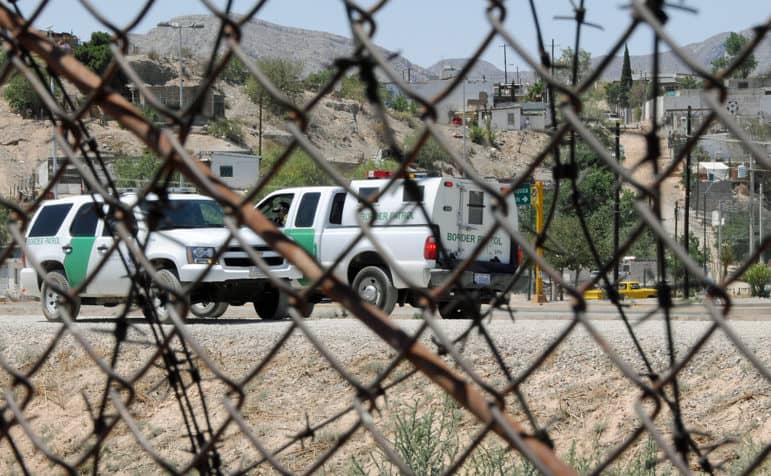
Heath Haussamen / NMPolitics.net
A scene from the U.S./Mexico border. In the foreground, behind a barbed-wire fence, U.S. Border Patrol agents speak with each other in El Paso, Texas. Across the Rio Grande, in the background, is Cuidad Juárez, Mexico.
With President Trump deploying 7,000 troops this month to help the U.S. Border Patrol confront a migrant caravan from Central America, one important question stands out: How well are government forces trained to deal with a large group of civilians?
The migrants are unarmed, though several of them reportedly threw rocks at Mexican officers as they crossed that country’s border a few weeks ago. President Donald Trump recently said any rocks thrown at troops would be considered a rifle after a reporter asked if the military would fire at the migrants.
“We’re not going to put up with that. They want to throw rocks at our military, our military fights back,” Trump said. He later backtracked on his comments, saying that migrants would be arrested instead.
An estimated 4,000 migrants are traveling hundreds of miles to the border. As of Tuesday morning, the group was gathered inside a stadium in Mexico City.
Reveal asked Customs and Border Protection about the kind of training officers would complete in anticipation of the migrants’ arrival. They provided a statement saying officers will be “participating in operational readiness exercises.” The agency didn’t respond to a reporter’s follow up questions.
Reveal posed the same questions to the Department of Defense. General Terrence John O’Shaughnessy, the commander leading the border operation, told reporters last week that troops would receive use-of-force training.
“We are, in fact, as an example, setting up training programs that’ll be all the way from a large scale mass training that will then go down to unit training,” he said.
Pentagon spokesman Jamie Davis told Reveal that training will depend on each troop’s assignment. He said he didn’t immediately have details about what the training would entail.
“I don’t have that in front of me,” he said.
In general, soldiers are instructed to use force to defend themselves from “imminent threat of physical injury or death,” as well as to overcome resistance during an arrest, prevent destruction of military property, or to control or restrain animals, according to a Department of Defense directive obtained by the Federation of American Scientists. They are also trained in “scaled use of force,” which includes a variety of non lethal tactics such as voice commands, pepper spray and batons.
Besides the thousands of troops, the military will be providing helicopters “to support the movement of CBP tactical personnel,” as well as medical teams, temporary housing, light towers, and fencing materials like barbed wire, according to the Department of Defense.
Then there are the so-called militia groups who say they are headed to the border to confront the caravan.
Although some of them may be veterans, most of these armed civilians won’t have the same formal use-of-force training that the military provides. The militias are governed by another set of rules: Forty-one states have laws restricting private military activity, including Arizona, Texas and California.
Meanwhile, the migrants have about 600 miles between them and the U.S.-Mexico border. It’s unclear how many will actually make it to the U.S. border.
The last caravan that formed in Central America totaled about 1,500 migrants. By the time is reached San Diego in May, it had dwindled to a few hundred.